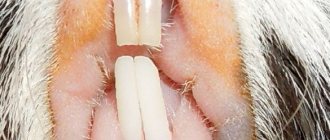- home
- Chinchilla
- Acquisition
03/23/2019 The first thing that interests future owners when choosing a pet is who is in front of them: a boy or a girl?
The care of the animal and its character are related to the characteristics of gender. It is quite difficult to determine the sex of a chinchilla, but it is possible. You need to know how to do it correctly. It is advisable to become familiar with the differences in behavior characteristic of both sexes.
Chinchilla boy or girl - who to choose
If you only want one member to live in your home, the gender of the chinchilla will not make a significant difference. A boy chinchilla and a girl chinchilla are usually equally adorable and provide their owners with many happy and enjoyable moments. They all love to be petted, especially behind the ears or under the chin.
Both women and men have their advantages and disadvantages. No matter what gender your chinchilla is, its personality can be completely unpredictable. Either gender can be territorial. If you are buying your first chinchilla, the gender of the animal is unlikely to deter you. However, there are still a few nuances.
A male chinchilla, whose character is independent and very active, is not suitable as a pet for a child. Even though they look adorable, and in fact they are, it is not recommended for children to come into contact with them.
The fact is that small chinchillas have a very thin skeleton, which can be damaged if a child squeezes the animal too tightly in his hand. Of course, a child will not want to harm an adorable animal, but he may accidentally break its ribs. Babies are also incredibly fast and constantly jump around underfoot - there's a very good chance they'll get stepped on.
Female chinchillas tend to protect themselves, so if you are buying a pet as a gift for a baby, it is best to choose this option.
Ways for the lazy
At the heart of laziness is the desire not to do something yourself. Therefore, if you bought chinchillas and do not want to take part in determining the gender of your charges, you can shift the responsibility onto someone else’s shoulders. Namely, on the shoulders of the following characters:
- for a veterinarian;
- to a chinchilla seller.
Let's see what consequences can await you when choosing one of these two options.
If you have made a choice in favor of a veterinarian
The only prerequisite here should be the choice in favor of a good veterinary clinic, since some inexperienced doctors can injure the animal during the examination. It is best to immediately ask the selected specialist if he has ever dealt with chinchillas and whether they have determined their gender. This question is by no means an idle one, since in many small towns these seemingly common animals were never treated by veterinarians due to their absence.
If you have an experienced veterinarian in front of you, then the probability of correctly determining the sex will be close to 100%, since over the years of study and work he has already learned to determine the sex of the animals that interest us.
If you have made a choice in favor of the seller
We do not recommend trusting a chinchilla seller, even if he makes a very good impression. If you buy an animal at a pet store, then there is a possibility that the seller really knows how to determine the sex of chinchillas. However, if you buy an animal secondhand, from breeders, then you are taking a pig in a poke. If you come across an unscrupulous breeder, he may tell you the sex of the animal at random.
In addition to the fact that you may be misinformed by an unscrupulous seller about the animal’s gender, there is a high probability of purchasing underdeveloped offspring with poor health indicators.
If a breeder does not know where he has boys and girls in his litter, he does not breed them. Upon reaching sexual maturity, closely related chinchillas begin to mate uncontrollably. As you know, intercourse between brothers and sisters produces large offspring with multiple developmental defects.
Prices for swimsuits for chinchillas
Gender characteristics
Many chinchillas like to live in duets with other representatives of their species. However, it should be remembered that chinchillas have some differences between the sexes. If you plan to keep several animals together, consider which gender of chinchilla you choose.
Female chinchillas are stronger than male chinchillas. They can be aggressive towards other women and men if they stick together. Mature chinchillas can even kill their neighbor if it is a young male chinchilla.
It's also worth remembering that chinchillas can be especially destructive when they're hot, as they will show signs of territorial aggression especially strongly.
During this time, it will be better if the chinchilla lives separately from other animals. Separating animals from each other can help prevent injury or death if aggression occurs. A male chinchilla will most likely be calmer.
Formation of a breeding pair
The gender of the chinchilla is especially important if you plan to have two pets. There are features that should be taken into account when forming pairs. For breeding, you need to take individuals from different litters, otherwise the offspring will have physical defects and low immunity.
You also need to be able to form a couple. In chinchillas, relationships are formed according to the principle of matriarchy. If a male is placed with a female, she will react aggressively to the fact that a new resident has appeared on her territory. It is very rarely possible to solve this problem and remove the negative factor. It is much easier to first get a male and then place a girlfriend with him. This way the pair will form faster. To do this, you also need to be able to determine the sex of a chinchilla.
Features of males and females
External differences between people are almost invisible. Sometimes girls can be bigger. The wool coat and body shape are completely the same. Women tend to be more active, they love to play and explore everything around them.
This is due to the fact that under natural conditions, females in herds occupy a dominant position. But they are also more emotionally sensitive. During hot weather they can become aggressive.
Because women are more active, they require more time and attention. If you don't take your pet for a walk in the evening before bed, he will make noise at night to attract his owners' attention. Women will do this more persistently.
For pets, it is necessary to organize a children's playground, which will include labyrinths, hammocks, a house, and stairs. If a girl does not have such an angle, she will have nowhere to get rid of her boiling energy. You need to know this when buying a pet.
For children, try choosing a boy chinchilla. They are believed to be calmer and easier to tame. They have a more malleable character. Although it also happens that they are indifferent to their owners. This is another extreme that does not suit everyone. They don't bite when you hold them, but they don't show affection either. They are reluctant to come into contact with people.
However, it is not always possible to distinguish a boy chinchilla from a girl by behavior and character. Boys can also be very active and curious, and prone to stress.
Character, behavior and habits
Each animal has its own character, but there are features that unite this species. All animals are very inquisitive. They will not ignore changes in the environment and new things in the cage. They react violently to the arrival of guests and find a favorite among family members.
Shushi are nocturnal animals; they like to sleep during the day. Watching them sleep is very funny. Everyone has their own preferences: some sleep on their sides, others curl up in a ring or take another “uncomfortable” position. Usually the animal wakes up at 7-8 pm, and its peak activity occurs at 10 pm.
Chinchillas make very interesting sounds. Each sound has its own meaning, and with their help you can understand how the animal feels. Lonely shushis often make searching sounds. This is how they try to find their relatives. A male paired with a female often sings a mating song and performs a dance, twirling his tail.
When the animal gets angry, it begins to click its teeth and make a cracking sound. If her displeasure is caused by a person or another chinchilla, she may attack the offender. Their attacks are quite funny: the snarling rodent stands on its hind legs, stretches out, releases a stream of urine and tries to bite. Their bites are harmless. Despite the fact that they have sharp and long teeth, they are not able to bite through the skin.
Relationships with rodents and other animals are usually complex. Shuni do not pay attention to other animals as long as they are not touched. But as soon as a cat or dog becomes interested in the animal, he will begin to experience severe stress. If you want to keep a chinchilla in a house where there are already pets, give it a separate room.
Chinchilla pregnancy chart.
Upper date—female mating Lower date—appearance of young
For example: taking the mating date of January 16 means that the cubs should be born around May 6, consider that the female's period of birth can vary from 106 to 114 days, the table is approximate plus 1-4 days.
You have read the article about breeding and sexing of chinchillas. You can ask all your questions about chinchillas on our forum, in the Livestock Forum section
Relationships between same-sex animals
The chinchilla is a pack animal, so the social aspect is very important for it. Being alone, the animal can become sad, lose activity and become very timid. Therefore, you need to add someone to his cage, but before that it is advisable to accurately determine the gender of the chinchilla - his companion.
- If one female is paired with another, this can lead to unpredictable consequences. They constantly strive to occupy a leading position and often enter into battles with the goal of “establishing their own order in the house.”
- To ensure that the adaptation period of the animals passes as calmly as possible, they are brought together on neutral territory, in the absence of various odors and marks. Meanwhile, the cage is thoroughly washed using strong household chemicals.
- Until the animals are placed in one space, they are kept for some time (3 – 7 days) in different cages, located nearby, but at the same time having one bathing suit for both. This way the animals quickly get used to the smell of their “neighbor”.
- Male chinchillas get used to a new companion faster, but they also need a preliminary stage of acquaintance in order to avoid unnecessary stress and aggression.
- As practice shows, same-sex chinchilla babies from the same litter get along faster.
Even having figured out how to distinguish the sex of a chinchilla, you need to act with extreme caution so that during examination the frightened animal does not bite your hand.
Did you like the article? Share with friends: [supsystic-social-sharing id=”1"]
- Related Posts
- How to make safe toys for chinchillas with your own hands
- What trees can chinchillas chew?
- How to choose the right cage or display for a chinchilla
« Previous entry
Pregnancy and newborn chinchillas
Chinchillas have a long gestation period of about 110 days. Births usually occur in the morning, within minutes of each other.
Chinchillas are born covered in fur, with their eyes open, and weigh about 60 grams. They are quite active from birth and can run around. The small size is usually small, with an average of 2 puppies born, but up to 6 can be born.
A woman is protective of her baby and can become very aggressive towards potential danger or those who threaten her babies. Chinchilla mothers are good parents and provide warmth, milk, and protection to their litters. Some fathers can also be good caregivers, but some may become aggressive towards their puppies and even try to kill them.
Chinchillas will be able to eat solid food at about a week of age, but will still be dependent on their mother and her milk until about 8 weeks of age. Once weaned, the young chinchillas will be ready to go to their new homes.
Reproduction
For those who decide to start breeding chinchillas, you need to know how to distinguish a boy chinchilla from a girl. Now we know this and it’s time to talk about the reproduction of these rodents.
A chinchilla's pregnancy lasts almost 4 months, namely 110 days. In the first two months there are no changes in the pet’s appearance. Unless the nipples become larger and become red in color and the appetite increases. During this period, the lady should be fed balanced food in increased portions.
Before giving birth, the male is removed if he lives in the same cage with the expectant mother. And they do not return him to the family until the babies are separated from their mother. There are usually two babies in a litter. Babies are born “in a fur coat”, with open eyes, and have teeth. The mother feeds them for 45-60 days, despite the fact that the babies are already eating adult food with might and main.
Upon reaching two months, children are seated by gender. We remember how to distinguish boys from chinchilla girls.
Behavioral characteristics of the male
There are a number of traits that are common to animals of a certain sex, but you can't tell for sure if you're looking at a male or female. For example, this is usually a woman:
- more than boys;
- more active;
- take a dominant position.
It is typical that males jump on the female from behind, but often the owners of these animals notice similar behavior of a girl towards a boy. Each animal has its own personality, and size depends on color and genetics, so these criteria cannot be relied upon with confidence.
Male rodents almost never bite and are known for their calm dispositions. Even they only scratch accidentally or in extreme situations. But at the same time, such a person can hardly be called calm. Sometimes she can be very nervous, which should be taken into account when purchasing and further raising her.
Young chinchillas, during their first stay in the house of a new owner, can hardly leave the house. If he is scared and hiding, he should not be disturbed unnecessarily.
Read more: Chinchilla diseases - their symptoms and treatment
But active acquaintance and play with it can only begin a few days after acquisition, when the animal gets used to the new atmosphere. Otherwise, the incompetent actions of the owner can permanently damage the delicate psychology of the animal. In addition, male children prefer a nocturnal lifestyle. Therefore, placing their cage in a room where people sleep may not be desirable.
Pets can make incredible noise while running and playing. However, they will be an ideal companion for people who are very busy and cannot devote much time to their pet.
Best companions
While female chinchillas can sometimes be aggressive with other females, most of their aggression is directed towards males trying to mate with them. therefore, if you already have a boy chinchilla , it is better to place another male with him. Fixed opposite sex duets sometimes work, but generally only in cases of littermate siblings. Littermates who have never been separated feel comfortable together and are therefore less likely to fight. For these exotic rodents to live together, it is better to equip the most spacious enclosure.
Neighborhood of individuals
An animal like a chinchilla is considered a beast of burden. Keeping just one chinchilla can lead to shyness and apathy. To avoid these consequences, it is recommended to have a couple of chinchillas at the same time. If breeding is not desired, you can purchase two females. However, it is worth remembering about possible conflicts and battles for territory and leadership in the herd.
Negative aspects can be minimized by introducing the animals to a neutral location without marks or odors. To do this, thoroughly clean the cage of the chinchilla's secretions with detergent. Buying a new, larger cage is also a good option.
The best choice for a rooster is to have two individuals of the same sex produced in the same litter. Such animals easily tolerate the proximity and smell of another excrement. Chinchillas are wonderful little pets that, if raised properly, will delight their owners with playfulness and affection.
Differences between female and male rats in appearance and character
Experienced owners who keep three or more rats claim that a girl is distinguished from a boy not only by physiological signs, but also by behavior. And in the appearance of tailed pets you can also notice distinctive features that allow you to determine where the female is and where the male is:
- male representatives are slightly larger than females and have a more powerful and robust physique;
- girls have a graceful elongated body, and boys have a pear-shaped body; If we compare the structure of the fur, then females have smooth, silky and soft fur, while males have harder and denser fur;
- females are inquisitive and restless and actively explore the surrounding objects, testing all things “by tooth.” Boys behave calmer, can sit in their house for a long time and spend all their free time sleeping;
- females are more aggressive than males and often bite their owners, especially if the animal is frightened or defends its offspring;
- You can tell a boy rat from a girl rat by the smell of their feces. In adult males, the urine has a sharper and more unpleasant odor than in females.
Important: if the owner plans to keep two rats in one cage, but does not want to breed them, then it is better to purchase females for this purpose. Girls get along well and get along well with each other, while two boys can start fights over territory and food
To control the reproduction of tailed pets, it is advisable to determine the sex of rodents no later than they reach one month of age, and place males and females in separate cages.
Before purchasing a rodent, it is important to evaluate the pros and cons of rats, whether it is right for you and whether you can care for it. It is also an important question to learn how to determine the age of a rat, in order not to get into trouble and not acquire an elderly animal.
Determining the sex of domestic rats 3.4 (67.59%) 58 votes
Rats are social animals, and if you do not want your pet to be sad, it is better to have them in pairs or groups. It is very desirable that they be same-sex, since these rodents are unusually prolific
Therefore, it is very important to correctly determine the sex of the rat. Puberty in these domestic animals begins at 5-6 weeks of age, so until this time, different-sex individuals need to be placed in different cages
Negative sides
Do such adorable animals have any drawbacks? Like all other animals, you cannot do without them.
- Chinchillas are scared. Fear can lead to cardiac arrest. Therefore, they need silence, these animals cannot tolerate loud noises, as mentioned above.
- If you let your pet out for a walk, do so only when accompanied by its owners. Otherwise, he will bite everything that gets in his way. He also bites couch cushions and wires.
- Their bite is very painful. If you grab the animal roughly and sharply, you will have to meet its sharp teeth.
- They love to swim in the sand. At the pet store you can purchase special sand for bathing chinchillas. And a bathing bowl with high sides. Otherwise, the entire area around the cage will be covered with this sand.
- A difference has been discovered between a boy chinchilla and a girl chinchilla. You will need it to avoid buying two males. These buds are unlikely to get along in the same cage. Constant bickering and mutual unloading are guaranteed if they live together. It is better to leave two females, they are much calmer and more devoted to their comrades.
Character of the female chinchilla
In the wild, females of these animals are the leaders in the population. Therefore, even in captivity, a female can injure a male if he is placed in her cage, for example, for the purpose of mating. When breeding animals, a girl must be placed with a boy, but not vice versa.
The female in the apartment behaves very actively, trying to explore every corner. At the same time, she really does not like to be in the arms of her owner. But these animals, despite this, love communication with people. They are very cheerful and cheerful, which can be a little disturbing for overly nervous or busy household members. Such rodents greatly value freedom, so they need to be given the opportunity to run around the rooms. And their cage must certainly be equipped with all kinds of toys, a wheel, ladders and the like.
Fashionable women's leather jackets - new items, trends, the most stylish models of leather jackets
The female chinchilla easily learns simple commands and remembers her name perfectly. She can be taught some exciting and funny tricks. But it is also important to understand that communication between such a rodent and its owner may be reduced to a minimum if the girl lives in the same cage with an individual of the same sex.
Determining the gender of a chinchilla
Once the animal loves and trusts you, you can finally begin the gender identification process. Observing the animal's behavior, appearance, and careful examination of the genitals will help you determine whether the animal is male or female.
Why do you need to know the gender of the animal in front of you? Let's list the circumstances in which you might need this information:
- you have a pet and want to make it your friend;
- We intend to breed chinchillas and want to buy a female and a male;
- She breeds chinchillas and wants to breed her adult puppies to prevent the female from getting pregnant early.
In fact, chinchillas can begin producing offspring as early as 3-4 months of age, but this animal pregnancy correlates with teenage human pregnancy. This is dangerous for the expectant mother and often ends in the birth of weak and sick puppies that die after birth.
Determining gender by appearance
Male and female chinchillas do not differ in color, but they also have other distinctive external features. Female chinchillas are much larger in size than their male counterparts. Because of this factor and the special temperament of female chinchillas, they are usually responsible for a couple.
When buying chinchillas in a store, do not trust the above signs that help determine sex, because animals in the same cage may come from different litters. Thus, small animals are not necessarily males, and large animals are not necessarily females. And they play more actively than adults.
The size of the live animals you buy in the store may depend not only on age, but also on nutrition and health. Sick or weak animals will not catch up with healthy animals of the same age. If an animal does not get enough nutrients from its diet, it will delay its physical development.
Determining gender by behavior
Don't jump to conclusions about the sex of an animal if you see one jumping on the other, inviting him to start mating. The fact is that dominant females can imitate the behavior of males by sitting on their backs and making characteristic movements. This behavior is absolutely normal for chinchillas.
During sexual hunting, differences in the behavior of females and males become noticeable. The female chinchilla becomes restless, active and refuses to eat, and may start throwing food around the room. Her genitals become intensely pink and a whitish fluid begins to leak from them.
Hunting males become animated and sing songs to females, making a long snorting sound. Matchmaking does not occur until adolescence; they may begin to hunt each other a little earlier. Chinchillas become fully mature at around seven months of age.
Determining gender by genitals
To determine the sex of an animal with absolute certainty, it is necessary to examine its genitals. This should be done carefully and not subject the animal to severe stress. First of all, hug the animal on your lap, speak in a gentle voice and begin to examine it.
Boudoir dresses for a bachelorette party: how to choose?
Sexual characteristics of the animal
You can tell which is a boy and which is a girl by looking at the chinchilla's genitals. For a person who has not previously had experience in determining sex, this method may seem quite difficult, especially if only one individual has fallen into their hands. But when there are several animals of different sexes in a cage at once, then when comparing their genitals, it will be much easier to distinguish, for example, where the males are.
To look at the animal's genitals, you need to take the chinchilla by the tail and remove it from the cage. After that, they turn her over with her back down and see what her genitals look like. Males will have testicles visible. They are a small mound near the anus. In fur-bearing animals that have not yet reached puberty, the testicles are weakly expressed, and therefore this method is more suitable for adult chinchillas.
The main method to distinguish between males and females is to determine the distance between the anus and the genitals. The gap between the anus and the penis in males is approximately 3 mm. If the examination is carried out on baby chinchillas, then the distance in boys will be less than indicated, but when compared with girls of the same age, the difference is noticeable. In females, the gap between the vagina and the anus is practically absent.
After the examination, it is recommended to give the animal a treat, as this procedure can cause stress in the pet, which will negatively affect its health.
When the female is in full heat, that is, ready for mating, it will be easiest to distinguish her from the boy. Her genitals swell slightly and become distinctly pink. She may refuse food, scattering it around the cage. A white-transparent fluid begins to come out of the vagina. If there is a male in a cage with a girl ready to mate, he changes his behavior. The boy begins to show more attention to the opposite sex. During the mating season, the male chinchilla makes a characteristic snort.
For professionals who constantly work with fur-bearing animals, finding out who is who is not difficult almost immediately after the animals are born. Therefore, if you do not have confidence in your own strengths and skills, it is recommended to purchase animals in specialized places. This could be a chinchilla farm or a pet store.
What to do if you are not sure about the correct gender of chinchillas?
If, after observing an animal's behavior and examining its genitals, there are still doubts about the animal's sex, the best solution is to compare several animals at once.
If possible, pick up 2-3 chinchillas at a time and place them on your lap. You may need the help of a second specialist during the examination. By comparing the reproductive organs of several chinchillas at the same time, you can more likely determine who is female and who is male.
Consultation with a seller at a pet store or breeder
When buying a chinchilla at a pet store, you can, of course, ask the seller about the sex of the animal. But there is no guarantee that the information received will be reliable, because often people working in stores have virtually no experience in animal husbandry, not to mention special education. But, most likely, the seller has experience in this matter.
When purchasing an animal directly from a breeder, it is also not always possible to obtain reliable information. Many unscrupulous breeders are willing to tell the buyer the desired gender just to buy the animal.
IMPORTANT: If a breeder cannot determine the sex of chinchillas, this means that he cannot correctly separate mature individuals, which leads to crossbreeding and the birth of offspring with developmental defects.
Consultation with a veterinarian
Experienced veterinarians can determine the sex of chinchillas with almost 100% accuracy. However, if the doctor has never dealt with such animals, the possibility of making a mistake cannot be ruled out. You must choose a good veterinary clinic and an experienced specialist.
Why do you need to know gender?
Some chinchilla owners don't even care what gender their pet is. They sincerely claim that they love both boys and girls of this type of rodent equally. However, ignorance of the sex of a chinchilla can negatively affect the keeping of pets for the following reasons:
- When keeping several individuals in one cage, gender plays a decisive role. Female chinchillas are more aggressive, especially during pregnancy and nursing. Moreover, girls have a more negative attitude towards representatives of the opposite sex. An angry female can even kill a young male.
- Females are more demanding of living conditions. At the slightest increase in temperature or humidity, they loudly signal discomfort. And females tolerate fluctuations in these indicators more painfully. Their vital activity immediately decreases, their appetite disappears, and their sleep worsens.
- Having bought a “male” at a pet store or poultry market, an unsuspecting owner can find newborn chinchillas in a cage 3-4 months later. A new addition to the family is, of course, a joyful event. But you need to carefully prepare for it, including mentally.
And for beginning breeders who plan to use chinchillas for professional breeding, the gender of the pet generally plays a key role. The cost of one baby of these cute rodents can reach 10-20 thousand. Therefore, females are much more valuable on the zoological market.
In addition, a novice breeder, 2-3 months after birth, will have to place the newly-born offspring in different cages. Therefore, you will have to prepare in advance to accurately determine the sex of the puppies.
General recommendations
We understand how to determine whether a chinchilla is a boy or a girl. We remind you that in boys the distance from the external genitalia to the anus is much greater than in girls. In females it is almost invisible.
How do you keep pets?
- Need a larger cage. The minimum cage size per person is 80*80*50. Can you now imagine the size of an apartment for several rodents?
- The cage is used to build a house. You can buy it or make it yourself. The house must be made of wood because these pets love to chew everything they see. Wood won't cause much trouble, but if they eat plastic, it's a disaster.
- They use corn filler as filler. This is the safest thing for these voracious animals that love to taste everything with their teeth.
- It is better to buy cast iron feeders that can be hung on the cage. Or heavy ceramic ones so that the chinchilla cannot knock them over.
- A drunkard must be big and hung up. Chinchillas do not drink a lot, but if they do drink, it is for a long time.
- There should be hay in the cage; animals love it.
- And don't forget the sand bath. Watching chinchillas bathe is a pleasure.
How to extend the life of a pet?
In order for an animal to live to a ripe old age, a rich life, it needs proper care.
Chinchillas are no exception. They need to create the right “habitat” in the apartment. That is, the place where they will live must be comfortable and fully meet their requirements in life. The cage for the animal should be spacious. The minimum area is 0.5 square meters.
The following devices must be installed in the cage:
- a house in which the animal will hide;
- wooden shelves for teeth points;
- hanging drinking bowl;
- feeder, can be either wall-mounted or floor-mounted;
- mineral and salt stones for sharpening teeth - they can also be a source of minerals and vitamins for animals;
- fill the floor with special wood filler;
- hanging canopy.
The video below clearly shows what should be in a chinchilla's cage, and why all this is needed.
It is also important to monitor the temperature of the room in which the chinchilla’s cage is located. In nature, they are accustomed to cool mountain air
At home, you need to get closer to a similar temperature. Although up to 25 degrees Celsius is considered a suitable temperature, the ideal room temperature will still be about 17 degrees above zero. This temperature is more similar to the highlands of South Africa.
In the wild, chinchillas are accustomed to making their own sand baths. This is how they take care of their hygiene and, accordingly, their health. You cannot deprive them of this procedure at home. Bathing in the sand should be regular and even daily. To do this, you can put a container with sand in the animal’s cage, deep enough so that it can bathe on its own whenever it wants.
Nutrition plays one of the most important roles in the process of healing and increasing the longevity of chinchillas.
There is a list of foods that should be avoided in a rodent's diet.
- Sweet foods, such as grapes. Chinchillas' bodies do not produce insulin, which means they will not be able to cope with blood sugar.
- Fatty nuts have a negative effect on the liver of animals, and this also includes sunflower seeds.
- The stone fruit tree, its branches and fruits contain hydrocyanic acid, which is poisonous to rodents.
- Coniferous tree branches.
- Toxic substances that may be contained in paper products (such as newspapers and wallpaper). They poison the body and lead to diseases of the animal’s gastrointestinal tract.
At what age is the sex of a chinchilla determined?
It is difficult to distinguish a boy chinchilla from a girl chinchilla even in adulthood, and young chinchillas up to a year old look the same.
Behavioral characteristics also cannot serve as a criterion. If a chinchilla jumps on the back of another, this can be either a natural action of the male or a sign of dominant behavior of the female - matriarchy occurs in chinchillas, and the female takes on the role of leader of the group. Therefore, the only way to determine the gender of a chinchilla is to examine its genitals.
However, the examination does not guarantee accuracy - externally, male and female organs look very similar, the only difference is the position relative to the anus.
In small animals this crack is very small, 1-3 mm, so it is very easy to confuse a boy with a girl. Over time, this difference increases, making it easier to distinguish males from females in adults.
IMPORTANT: chinchillas are able to reproduce from the age of three months, so the issue of gender determination is quite serious.
Early pregnancy (up to 6-7 months) can also destroy a woman’s health. Therefore, it is very important to distinguish between the sexes in time and separate boys and girls into separate cages.
Cubs
Due to the fact that the genitalia of the cubs of this animal are even smaller than those of adults, determining sex becomes a more difficult task. However, it is still necessary to complete it.
Chinchillas are able to reproduce as early as three months of age, however, this can become very stressful for the female. Therefore, sex determination and placement of boys and girls of this species of animals must be carried out before the age of three months.
In order to find out the sex of the animal, there is an alternative option - show the animal itself or a photo of its genitals to a specialist. It could be:
- professional breeder;
- veterinarian.
When transporting chinchillas to a veterinary clinic, care must be taken to ensure minimal stress for the animals. To do this, you can cover the cage with a towel, and in winter, first place small pieces of fur and wool in it, in which the animals can hide from the cold.
How to determine the sex of a chinchilla puppy
Sex in newborn chinchillas is quite difficult to determine, and even experienced breeders cannot always distinguish young animals from each other. If a chinchilla is giving birth for the first time, it is best to take photographs of the newborns and show them to a professional breeder or gardener.
In baby chinchillas, sex is determined in the same way as in adults - by the distance between the anus and the penis or vagina. The difficulty, however, is that this distance may be the same in infants.
Sometimes this helps if there are five or six puppies in the litter. Mixed-sex puppies are a must, and careful comparison can tell the difference between boys and girls.
You may want to wait a few months for the puppies to grow up. Once sexes have been determined, place females and males in separate cages to prevent accidental and unwanted mating.
Going to the pet store
If you want to keep several individuals at the same time, it is very important to differentiate which one you buy. This is the key to preventing a showdown, also to avoid unplanned reproduction, or, on the contrary, to provoke it
People who are just planning to have such a funny and active pet in their home are wondering what the differences are between a male and a female? After all, different sexes often have different habits, behavior, learning abilities, and so on. It is worth noting that if you choose a chinchilla for solitary housing, then gender is not particularly important, but there are still some features.
There are practically no external differences; if there are any, they are extremely difficult to notice. You can tell which is a boy and which is a girl by observing the animals. Girls are bolder and more active than males. Precisely because females are more interesting in behavior and interesting to watch, they are more often chosen as the only favorite.
Living in nature in a pack
of these animals, it is the females that dominate.
But, despite the advantages of active behavior, the female can be more aggressive during the period of heat, and girls are also susceptible to stress.
Male chinchillas are more flexible than their female companions. They are also easier to tame, which is a big plus; they do not show aggression.
How to avoid stress in chinchillas when determining gender
Chinchillas do not belong to the category of animals that immediately and unconditionally trust their owners. They are easy to scare and difficult to tame. And if you do something against their will, over a long period of time, they will lose trust in people.
Restoring contact will be difficult. Additionally, when they are stressed, they may refuse to eat or drink, experience hair loss, or have a weakened immune system. Therefore, before we pick up a pet and begin to examine it, we must gain its trust and tame it with our own hands. Therefore, he must understand that no manipulation on the part of the owner will cause harm.
A baby chinchilla needs at least a month of training. A chinchilla needs to be handled gradually. You can help overcome the psychological barrier by talking gently to your pet and offering him something to eat out of your hand. Gradually, the animal will gain self-confidence and will not be afraid when you pick it up.
Only when the animal has become accustomed to being handled can the animal's genitals be examined without psychological consequences to determine whether it is male or female.
Ready-made pair or to choose from
In the wild, chinchillas live in herds of 10 to 100 individuals. The chinchilla is a collective animal, so keeping a pair of chinchillas is more consistent with the nature of the animals than keeping them alone.
Ready-made pairs of chinchillas are rarely offered for sale. Previous owners sell them because the animals are old or if the couple is childless. And if you do not plan to engage in breeding, then this option is acceptable. Sometimes couples who have previously had children and chinchillas are of childbearing age go on sale. Such a couple can still bring you offspring. Find out from the seller how many litters the couple had previously and what quality the chinchillas turned out to be.
The most interesting thing, from a breeding point of view, is to select pairs of chinchillas. The selection process is the main thing in the work of a breeder. The purpose of selection is to obtain offspring with new variations in color and fur quality. To succeed, you need to know the pedigree of chinchillas and the laws of genetics. Do not attempt to breed chinchillas unless you have the necessary knowledge; some gene combinations can be lethal. If you buy chinchillas from a breeder, you will receive advice about the likely quality of the offspring.
If you have one chinchilla and you decide to buy a second one, know that you cannot immediately put two chinchillas in one cage. Whether they are same-sex or opposite-sex animals, their reaction to each other can be sharply aggressive. Raising chinchillas is a separate and large topic, which is described in the section on breeding chinchillas>>>.
In the photo: A pair of chinchillas for keeping as pets
Let's sum it up
Determining the sex of chinchillas is not an easy task. Not only does their size make it more difficult, but they must be used to your touch beforehand or they won't let you touch them.
The sexing of chinchillas, unlike the methods to which we are accustomed, differs not in the presence of genital elements such as testicles, penis or cock, but in the distance from the animal's anus to its gonad. The size of this distance in males varies from 1 to 4-5 millimeters; in females it is almost or completely absent. If you are unsure about the sex of the chinchilla you want to test, you can test another animal at the same time with the help of a friend. By comparing them with each other, you will quickly find out who is who.
Testing to determine the sex of chinchillas should be done with extreme caution, as strong pressure and reaching can injure or stress them.
The sex of these unusual animals can also be determined by observing their habits. There is a stable matriarchy within this species, so the most impudent animal in the cage will probably be the female.
Certain features of appearance can tell you whether you see a man or a woman in front of you. If the animals you are interested in are the same age, the female will always be larger and more active than the male. However, if the animals are of different ages, then the method of determination by appearance is not reliable.
How to proceed?
Before you begin examining your pet, you need to make sure that he is calm and does not show signs of aggression. Determining the information you are interested in will not take much time. Next, follow these steps:
- Remove the animal from the cage. Carefully turn it over, you need access to the belly.
- Take your baby carefully and comfortably, hold him under his front paws with one hand, and pull his tail back with the other.
- Take a good look at the genitals. If the animal is in a calm state, it should not resist this inspection.
- In males you will see a fairly wide distance between the genitals, in females it is smaller, as can be seen in the photo.
Once you've completed your inspection, return your pet, pet it, and maybe even offer a treat.










